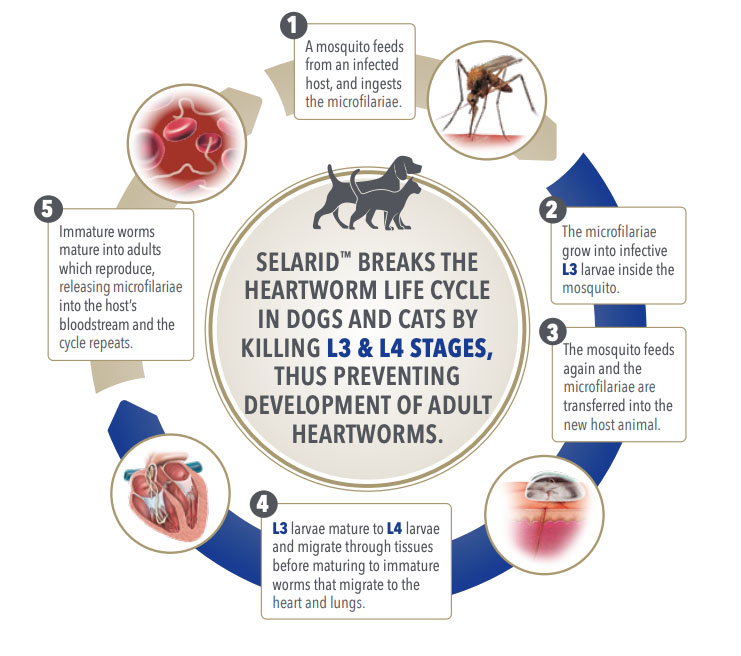Selarid (selamectin) for Dogs
+ Save on each recurring order!
Free Shipping on orders over $75
Low Price Match Guarantee
- Protects against heartworm, fleas ticks, roundworm and more!
- Available Sizes
- 3 Dose (For Puppies & Kittens)
- 6 Dose
Description
Now there's a cost-effective option for protecting your pets against some of the more common parasites.Selarid™ (selamectin) Topical Parasiticide for Dogs from Norbrook® is an affordable monthly topical prevention option for heartworm disease, flea infestations and more. With the same active ingredient as Revolution® Topical Solution, Selarid™ offers parasite control that’s comparable to the pioneer product at an affordable price.
Selarid Treats and Prevents
- Heartworm (Cats & Dogs)
- Fleas (Cats & Dogs)
- American dog tick (Dogs)
- Roundworms (Cats)
- Ear mites (Cats & Dogs)
- Sarcoptic mange (Dogs)


Flea Control in Dogs & Cats
For the prevention and control of flea infestations, Selarid should be administered at monthly intervals throughout the flea season, starting one month before fleas become active. In controlled laboratory studies ›98% of fleas were killed within 36 hours. Results of clinical field studies using selamectin solution monthly demonstrated › control of flea infestations within 30 days of the first dose. Dogs and cats treated with selamectin solution, including those with pre-existing flea allergy dermatitis, showed improvement in clinical signs associated with fleas as a direct result or eliminating the fleas from the animals and their environment.
If the dog or cat is already infested with fleas when the first dose of Selarid is administered, adult fleas on the animal are killed and no viable fleas hatch from eggs after the first administration. However, an environmental infestation of fleas may persist for a short time after beginning treatment with Selarid because of the emergence of adult fleas from pupae.
Heartworm Prevention in Dogs and Cats
For the prevention of heartworm disease, Selarid must be administered on a monthly basis, Selarid may be administered year-round or at least within one month after the animal's first exposure to mosquitoes and monthly thereafter until the end of the mosquito season. The final dose must be given within one month after the last exposure to mosquitoes. If a dose is missed and a monthly interval between dosing is exceeded then immediate administration of Selarid and resumption of monthly dosing will minimize the opportunity for the development of adult heartworms. When replacing another heartworm preventive product in a heartworm disease prevention program, the first dose of Selarid must be given within a month of the last dose of the former medication. Selamectin, the active ingredient in Selarid, is a macrocyclic lactone compound. These compounds effectively prevent the development of adult heartworms when administered to dogs and cats within one month of exposure to infective (L3) Dirofilaria immitis larvae. Efficacy of macrocyclic lactones decreases below 100% in dogs, however, if first administered ›2 months after exposure to infective larvae. Thus, in heartworm endemic regions, delaying initiation of heartworm prevention using Selarid beyond 2 months of first exposure to infective larvae (e.g., starting puppies and kittens at >8 weeks of age), or gaps of ›2 months in the administration of Selarid during periods of heartworm transmission, increases the risk of the animal acquiring heartworms. Animals with unknown heartworm history that test negative for heartworms prior to the initiation of Selarid may be harboring pre-patent infections at the time Selarid was started. Testing such animals 3–4 months after initiation of Selarid would be necessary to confirm their negative heartworm status.At the discretion of the veterinarian, cats 6 months of age may be tested to determine the presence of existing heartworm infections before beginning treatment with Selarid. Cats already infected with adult heartworms can be given Selarid monthly to prevent further infections.
Ear Mite Treatment in Dogs & Cats
For the treatment of ear mite (O. cynotis) infestations in dogs and cats, Selarid should be administered once as a single topical dose. A second monthly dose may be required in some dogs. Monthly use of Selarid will control any subsequent ear mite infestations. In the clinical field trials ears were not cleaned, and many animals still had debris in their ears after the second dose. Cleansing of the infested ears is recommended to remove the debris.
Sarcoptic Mange Treatment in Dogs
For the treatment of sarcoptic mange (S. scabiei) in dogs, Selarid should be administered once as a single topical dose. A second monthly dose may be required in some dogs. Monthly use of Selarid will control any subsequent sarcoptic mange mite infestations. Because of the difficulty in finding sarcoptic mange mites on skin scrapings, effectiveness assessments also were based on resolution of clinical signs. Resolution of the pruritus associated with the mite infestations was observed in approximately 50% of the dogs 30 days after the first treatment and in approximately 90% of the dogs 30 days after the second monthly treatment.
Tick Control in Dogs
For the control of tick (Dermacentor variabilis) infestations in dogs, Selarid should be administered on a monthly basis. In heavy tick infestations, complete efficacy may not be achieved after the first dose. In these cases, one additional dose may be administered two weeks after the previous dose, with monthly dosing continued thereafter
Dosage and Administration

A veterinarian or veterinary technician should demonstrate or instruct the pet owner regarding the appropriate technique for applying Selarid topically to dogs and cats prior to first use.
How should Selarid be applied?
- Remove the applicator from the outer pouch using scissors or fold along diagonal line expose nick; tear back at nick.
- Hold the applicator upright. Tap the narrow part of the applicator to ensure the contents remain within the main body of the applicator. Twist or snap back the tip.
- Part the hair on the back of the animal at the base of the neck, in front of the shoulder blades, until the skin is visible.
- Apply the tip of the Selarid applicator directly to the skin. Squeeze the applicator firmly 3-4 times in one spot until empty. Keep applicator compressed on the final squeeze to avoid drawing liquid back into applicator. Avoid contact between Selarid and your fingers.
- While keeping applicator squeezed, drag it away from liquid and lift up to remove.
- Ensure applicator is empty
Do not massage Selarid into the skin.
Do not apply when the hair coat is wet.
Do not apply to broken skin - Selarid contains alcohol.
Stiff hair clumping of hair, hair discoloration, or a slight powdery residue may be observed at the site in some animals. These effects are usually temporary and do not affect the safety or effectiveness of the product.






